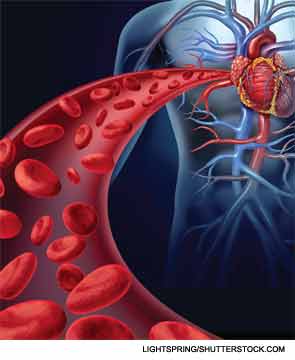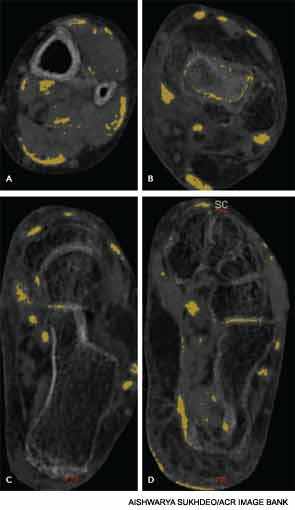
SNOWMASS, CO—Colchicine has been around for centuries and is commonly used in gout, but was only recently approved by the U.S. Food and Drug Administration (FDA) based on a new, safer dosing regimen. As a gout medicine, colchicine is “imperfect,” but it is safe if used correctly and is now listed as a first line of treatment for chronic gout and acute gout attacks in the ACR’s guidelines, according to Michael H. Pillinger, MD, associate professor of medicine and biochemistry and molecular pharmacology, NYU School of Medicine, who presented a session on colchicine at the ACR’s Winter Rheumatology Symposium.
Although colchicine is primarily considered a gout treatment, it deserves another look for its application in familial Mediterranean fever and its antiinflammatory effects, which make it of potential therapeutic value in osteoarthritis (OA) and cardiovascular disease.
Mechanism of Action
Colchicine’s antiinflammatory properties are not completely understood, but the theory is “that most, if not all, happen through microtubule inhibition,” Dr. Pillinger explained. “Colchicine irreversibly complexes with free tubulin dimers, binding between the alpha and beta subunits. Colchicine-tubulin complexes are then incorporated into the growing microtubule, blocking or slowing growth at both ends.”
Another mechanism by which colchicine has been shown to function is impairing cells’ ability to express selectins. Specifically, Dr. Pillinger noted, colchicine:
- Alters the expression of E-selectin on tumor necrosis factor (TNF)–stimulated endothelial cells when used in low doses,
- Diminishes stimulated endothelial adhesiveness for unstimulated neutrophils, and
- Alters the expression of L-selectin on TNF-stimulated neutrophils when used in higher doses.
The third “story” about colchicine’s mechanism of action is related to the inflammasome, Dr. Pillinger added, although this mechanism is less well documented and is a bit controversial. When activated, the inflammasome is hyperactive and creates too much interleukin 1 (IL-1).
“In gout, IL-1 is, if not the central cytokine, then a central cytokine,” Dr. Pillinger said. “So it’s become a big target.” The interesting thing, he said, is that laboratory studies have shown that colchicine “blocks the activation of the inflammasome,” suggesting that this is at least one action of colchicine. The controversy is because the study showing this inhibitory effect used very high doses.1
Another possibility is that colchicine increases production of pyrin, a molecule that is part of the inflammasome. People with familial Mediterranean fever, for example, have defective pyrin. “There’s evidence that colchicine might increase production of pyrin under some circumstances,” Dr. Pillinger said. “It’s a curiosity. How it really affects the inflammasome and how it really works remain to be discovered.”

Toxicity & Drug Interactions
Pharmacologically, colchicine is lipid soluble, has 24–88% bioavailability, accumulates in leukocytes and has a peak concentration one hour after administration. Although it is safe, colchicine can be toxic if it cannot be metabolized correctly. Taken orally, colchicine is handled in three ways, Dr. Pillinger explained: It is pushed out of the gut via P-glycoprotein, metabolized by the CYP-3A4 enzyme and excreted in the kidneys. If any of these mechanisms is upset by other factors—medications that compete for the same metabolic pathway or impaired kidney function, for example—colchicine can cause liver or kidney toxicity.
Medications of which rheumatologists should take note include HIV therapy, the antibiotic erythromycin and anti-fungal medications, Dr. Pillinger advised. Statins are another group that may have “overlapping issues” with colchicine, he added, perhaps due to competing metabolism along the CYP-3A4 pathway.
The key with potential drug contraindications is to “think about dosages,” Dr. Pillinger advised. Colchicine package inserts have indications for adjusting dosages based on particular medications, although the “mystery,” he added, is when a patient has more than one potential interaction with colchicine simultaneously—such as a patient on HIV therapy who also has kidney disease. The key, as with many medications, is to “use the lowest effective doses, adjust for renal or liver disease, and monitor sensibly,” Dr. Pillinger said.
Rheumatic Disease
Colchicine has been used for years in gout therapy—chronically at low doses to prevent attacks and in high doses to treat acute attacks. For acute attacks, the classic treatment regimen is 0.6 mg per hour until the patient experiences improvement, exhibits significant stomach upset and diarrhea, or to a limit of 4–6 g.
The AGREE Trial demonstrated a new way to treat gout, Dr. Pillinger said, which is what recently led the FDA to approve the drug. Researchers recruited patients with known gout who were fairly active and who were likely to experience an acute attack in the subsequent six months.2 Patients were randomized in the clinic and sent home with one of three regimens to use during their next acute gout attack: high-dose colchicine (0.6 mg/hr up to 4.6 mg), low-dose colchicine (1.2 mg, then 0.6 mg one hour later) or placebo. The primary endpoint was 50% improvement within 24 hours.
“The outcome of this was very clear—the patients who got the low dose had, in essence, as good an effect as the high dose and as safe an effect as the placebo,” Dr. Pillinger explained. “This specifically applies to patients who got treated early.” Of note, he added, colchicine was only about 40% effective.
Another study using colchicine as the control drug showed a similar efficacy rate.3 “The point [of the Schlesinger study] was that even prophylaxing, patients may get gout attacks. It’s a good drug, but it’s not a perfect drug,” he said.
As indicated in the ACR guidelines for gout, one way to increase efficacy of colchicine as a first-line treatment for acute gout is to add nonsteroidal antiinflammatory drugs and prednisone.
“If in gout, colchicine is a pretty good drug, then in familial Mediterranean fever, colchicine is a great drug. It has changed people’s lives and survival,” Dr. Pillinger said. He cited some older studies with “dramatic results” that showed about 90% of patients who were compliant with the drug regimen avoided inflammatory attacks and amyloidosis.
There is also some early evidence that colchicine may have application in OA, an inflammatory disease in which IL-1 and urate may be important, Dr. Pillinger said. There is a link between gout and increased prevalence and severity of OA, and two small trials suggest colchicine may help alleviate pain in patients with OA.
Cardiovascular Disease
The potential therapeutic value of colchicine in cardiovascular disease is a subject that rheumatologists and researchers are trying to understand better, Dr. Pillinger said. One thought is that the antiinflammatory action of colchicine may reduce the risk of myocardial infarction. In one study, gout patients taking colchicine exhibited a nearly 50% reduction in the incidence of myocardial infarction.4 There were also trends toward lower c-reactive protein and a reduced risk of death.
Further support for this connection is the CONSORT study, which involved 500 non-gout patients with preexisting cardiovascular disease. The trial demonstrated that patients taking 0.5 mg/d of colchicine or placebo for at least two years had about a 65% lower risk of any acute coronary syndrome, heart attack or stroke, Dr. Pillinger said.
“Gout is a disease of inflammation, and while the inflammation in gout may be more intermittent than in RA, gout patients are still known to harbor an increased risk of cardiovascular disease,” Dr. Pillinger said. “If this is an inflammatory disease, maybe controlling the inflammation in gout might decrease the risk of cardiovascular disease in these patients.”
Dr. Pillinger and his colleagues are conducting ongoing research into the link between gout, colchicine therapy and cardiovascular disease and, although the results are not ready, he noted that the trends they’re seeing in the interim data are promising.
Kimberly J. Retzlaff is a medical journalist based in Denver.
References
- Martinon F, Pétrilli V, Mayor A, et al. Gout-associated uric acid crystals activate the NALP3 inflammasome. Nature. 2006;440(9):237–241.
- Terkeltaub RA, Furst DE, Bennett K, et al. High versus low dosing of oral colchicine for early acute gout flare. Arthritis & Rheumatism. 2010;62(4):1060–1068.
- Schlesinger N, Mysler E, Lin H-Y, et al. Canakinumab reduces the risk of acute gouty arthritis flares during initiation of allopurinol treatment: results of a double-blind, randomised study. Ann Rheum Dis. 2011;70(7):1264–1271.
- Crittenden DB, Lehmann RA, Schneck L, et al. Colchicine use is associated with decreased prevalence of myocardial infarction in patients with gout. J Rheumatology. 2012;39(7):1458–1464.

